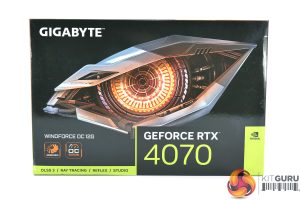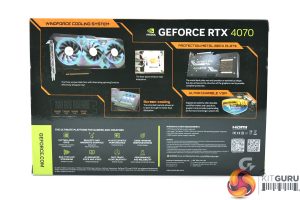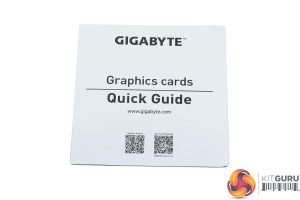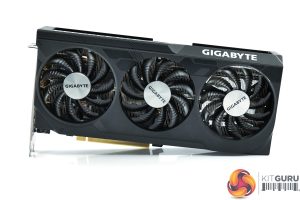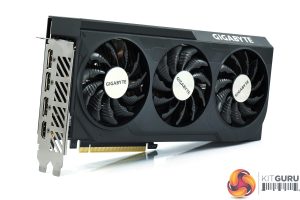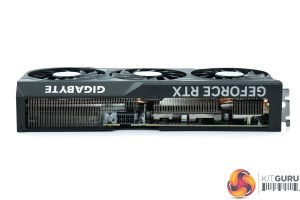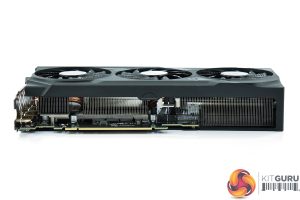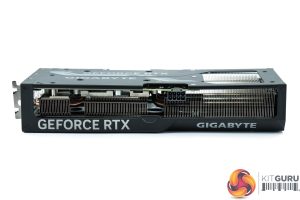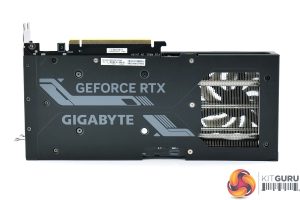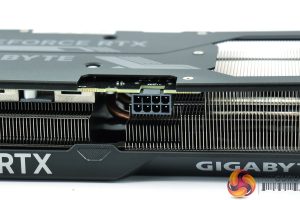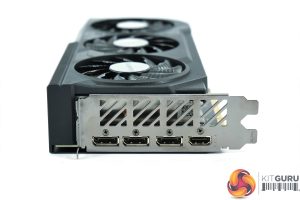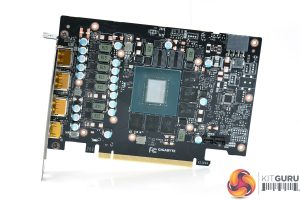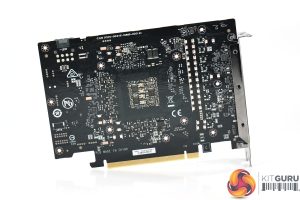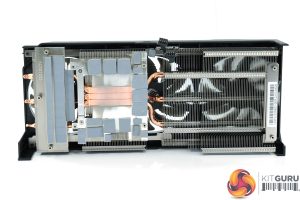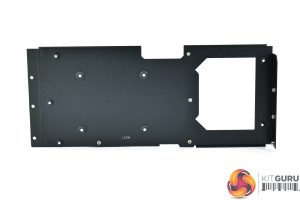The Gigabyte RTX 4070 Windforce OC ships in a very familiar-looking box, with a large robotic eye visible on the front along with the GeForce branding. On the back, Gigabyte highlights a number of key features.
Inside, the only included accessory is a quick start guide.
The graphics card itself is a fairly plain design, being almost entirely matte black with not a hint of colour anywhere – and that includes RGB, something which is not present on the Windforce. The shroud is made from plastic, but it feels reasonably sturdy in the hand.
Three 80mm fans sit within the shroud, and of course these feature Gigabyte's Alternate Spinning feature, where the central fan spins in reverse relative to the outer two, which Gigabyte claims should reduce turbulence and increase overall pressure down onto the heatsink itself.
I don't have official dimensions for the Windforce, but it is a touch larger than the Founders Edition while still being much more reasonable than other 40-series cards. My own measurements have it at approximately 262 x 129 x 48mm, so it's just a touch thicker than a standard dual-slot card.
The front side of the card is home to the GeForce RTX and Gigabyte logos printed in white.
As for the backplate, I was pleased to see this is still made from metal despite the Windforce being an MSRP card. It's mostly black, with a couple more logos and some grey accents to add a bit of visual interest.
As mentioned on the previous page, Nvidia is now allowing its partners to ship 4070s with a single 8-pin power connector if they wish – considering the TGP of the GPU is only 200W, this is no problem at all from a power perspective and means users don't need any adapters or new cables. Display outputs consist of 3x DisplayPort 1.4 and 1x HDMI 2.1.
After disassembling the card we get a good look at the PCB. Here Gigabyte has opted for 50A Alpha and Omega AOZ5311NQI MOSFETs across the board, with 7 phases feeding the GPU and 3 phases for the memory. A UPI UP9512R controller is used for the GPU VRM, with a UPI UP9529Q looking after the memory VRM.
Micron 16Gb GDDR6X memory modules are used, model number MT61K512M32KPA-21.
Gigabyte's cooler is relatively basic, but considering the power demands are much lower than other 40-series cards, it should be absolutely fine. Three 6mm copper heatpipes make direct contact with the GPU die. Three memory modules also contact with these heatpipes, while the other three meet with an aluminium baseplate. Separate baseplates are also used to contact the MOSFETs.
Despite using a metal backplate, Gigabyte has opted not to add thermal pads on the underside, something which can help memory thermals, albeit not very significantly.
Be sure to check out our sponsors store EKWB here
 KitGuru KitGuru.net – Tech News | Hardware News | Hardware Reviews | IOS | Mobile | Gaming | Graphics Cards
KitGuru KitGuru.net – Tech News | Hardware News | Hardware Reviews | IOS | Mobile | Gaming | Graphics Cards


